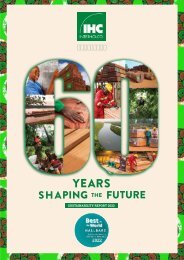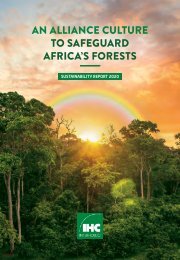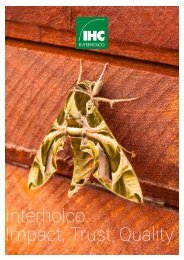Nomenclature Générale des Bois Tropicaux - 7ème édition
(english description below) Cette nomenclature est utilisée pour la mise à jour du 'Harmonized Code System' de l’Organisation Mondiale des Douanes. Dans la circulaire du 5 avril 2005, le Ministère de l’Economie, des Finances et de l’Industrie (France) reconnaît l’ATIBT comme « gardien du temple » de la nomenclature des bois tropicaux. La Commission Européenne mentionne la nomenclature de l’ATIBT comme document de référence pour la mise en œuvre du RBUE. Depuis 1954, l’ATIBT a établi et mis à jour une nomenclature des bois tropicaux faisant correspondre chaque espèce botanique avec un nom pilote reconnu internationalement. La détermination du nom pilote d’une essence est cruciale, car sa commercialisation dépend très largement de l’adoption de ce nom par le public. Le nom pilote assure la protection de l’appellation commerciale de l’essence et l’intégrité des propriétés qui lui sont attribuées, sans risque de confusion. The 1982 version of the general timber nomenclature has finally been updated as some of the 1,750 identified species, are no longer traded, while others, which were not previously included, are now on the market. The present revision has also integrated changes related to new taxonomy, in order to reflect the latest scientific developments. This Nomenclature has been used for the Harmonized Code System, updated by the World Customs Organization. The French Ministry of economy, finance and industry has given official recognition to ATIBT as the reference for the tropical timber nomenclature (NOR: PRMX0508285C of April 5th 2005). The European Commission refers to ATIBT nomenclature as a reference document for the implementation of the EUTR regulation. Since 1954, ATIBT has established and updated a nomenclature of tropical wood, linking each botanical species with an internationally recognized pilot name. A sigle wood species may have many common names; when trading across different countries, this may lead to confusion. Fixing the pilot name of a timber species is crucial, to protect the commercial denomination of the species and guarantee the veracity of the properties linked to that species, without confusion.
(english description below)
Cette nomenclature est utilisée pour la mise à jour du 'Harmonized Code System' de l’Organisation Mondiale des Douanes. Dans la circulaire du 5 avril 2005, le Ministère de l’Economie, des Finances et de l’Industrie (France) reconnaît l’ATIBT comme « gardien du temple » de la nomenclature des bois tropicaux. La Commission Européenne mentionne la nomenclature de l’ATIBT comme document de référence pour la mise en œuvre du RBUE.
Depuis 1954, l’ATIBT a établi et mis à jour une nomenclature des bois tropicaux faisant correspondre chaque espèce botanique avec un nom pilote reconnu internationalement. La détermination du nom pilote d’une essence est cruciale, car sa commercialisation dépend très largement de l’adoption de ce nom par le public. Le nom pilote assure la protection de l’appellation commerciale de l’essence et l’intégrité des propriétés qui lui sont attribuées, sans risque de confusion.
The 1982 version of the general timber nomenclature has finally been updated as some of the 1,750 identified species, are no longer traded, while others, which were not previously included, are now on the market. The present revision has also integrated changes related to new taxonomy, in order to reflect the latest scientific developments.
This Nomenclature has been used for the Harmonized Code System, updated by the World Customs Organization. The French Ministry of economy, finance and industry has given official recognition to ATIBT as the reference for the tropical timber nomenclature (NOR: PRMX0508285C of April 5th 2005). The European Commission refers to ATIBT nomenclature as a reference document for the implementation of the EUTR regulation.
Since 1954, ATIBT has established and updated a nomenclature of tropical wood, linking each botanical species with an internationally recognized pilot name. A sigle wood species may have many common names; when trading across different countries, this may lead to confusion. Fixing the pilot name of a timber species is crucial, to protect the commercial denomination of the species and guarantee the veracity of the properties linked to that species, without confusion.
Create successful ePaper yourself
Turn your PDF publications into a flip-book with our unique Google optimized e-Paper software.
Liste des noms pilotes des bois tropicaux avec renvoi aux noms scientifiques /// 57
PILOT NAME BOTANICAL NAMES COMMON NAMES
Cambara
Erisma nitidum DC.
Erisma uncinatum Warm.
Erisma spp.
Cambara (BR, PE) ; Cedrinho (BR) ; Felli Kouali
(GF) ; Jaboty (BR, GF) ; Manonti Kouali (GF) ;
Mureillo (VE) ; Quaruba tinga (BR) ; Quaruba vermelha
(BR) ; Quarubarana (BR) ; Singri-Kwari (SR)
Campèche Haematoxylon campechianum L. Campèche (MX) ; Logwood (HN)
Camphorwood
Canalete
Cinnamomum camphora J. Presl
Cinnamomum iners Reinw.
Cinnamomum porrectum Kosterm.
Cinnamomum p.p.
Cordia dodecandra DC.
Cordia gerascanthus L.
Cordia glabrata DC.
Cordia sebestena L.
Cordia p.p.
Canelo Drimys winteri J.R. Forst. & G. Forst. Canelo (BR, CL)
Canelón
Cangerana
Capomo
Cardeiro
Carreto
Casca
Castanheiro
Chinquapin
Catiguà
Cativo
Myrsine guianensis Kuntze
(Syn. Rapanea guianensis)
Cabralea cangerana Mart.
(Syn. Cabralea laevis)
Brosimum alicastrum Sw.
(Syn. Brosimum columbianum)
Scleronema micranthum Ducke
Aspidosperma megalocarpon Muell. Arg.
(Syn. Aspidosperma curranii)
Aspidosperma p.p.
Pradosia cochlearia T.D. Penn.
Pradosia schomburgkiana Cronq.
Pradosia surinamensis T.D. Penn.
Pradosia spp.
Bertholletia excelsa H.B.K.
Castanopsis fargesii Franch.
Castanopsis hystrix Hook. & Thomson
Castanopsis sclerophylla Schottky
Castanopsis p.p.
Trichilia catigua A. Juss.
Trichilia spp.
Prioria copaifera Griseb.
Cinnamon (IN) ; Cong Nao (VN) ; Hau Phat (VN) ;
Manthin (MM) ; Ré (VN) ; Willa (IN)
Amapa Asta (MX) ; Anacahuite (CU) ; Baria (CU) ;
Baricé (CU) ; Bocote (MX) ; Canalete (CO, VE) ; Cupane
(MX) ; Kopté (MX) ; Louro negro (AR) ; Louro
pardo (BR) ; Siriecto (VE)
Arrayàn (PR) ; Canelón (BR) ; Caporococa (BR)
Cancharana (AR) ; Cangerana (BR) ; Cangerana
(UY) ; Cedro-rá (PY) ; Pau de santo (BR)
Capomo (BR) ; Charo (BR) ; Guaimaró (CO, VE) ;
Laredo (MX) ; Lerado (MX) ; Machinga (PR) ; Ojoche
(NC) ; Ramón (MX) ; Sandé (CO, EC, VE)
Cardeiro (BR) ; Castanha de paca (BR) ; Castaño
(CO) ; Cedrinho (BR) ; Cedro bravo (BR) ; Cordeiro
(BR) ; Yolombo (CO)
Carapanaúba (BR) ; Carreto (BR, CO, VE)
Bacuri (BR) ; Buranhem (BR) ; Casca (BR)
Castaña (CO) ; Castana do Maranhao (CO) ; Castanha
do Brasil (BR, CO) ; Castanha do Para (BR, CO) ;
Castanheiro (BR) ; Jubia (VE) ; Nuez del Brazil (CO)
Chinkapin (CN) ; Chinquapin (CN) ; Chinquapin
(JP, US)
Catiguà (AR) ; Cucharillo (MX) ; Pau rosa branca
(BR) ; Pracuiba da terra firme (BR)
Amasamujer (CO) ; Camibar (CR) ; Cativo (CO, CR,
PA) ; Copachu (CO) ; Curucai (VE) ; Muramo (VE) ;
Trementino (CO)
Catucaém Roupala brasiliensis Klotzsch Carvalho (BR) ; Catucaém (BR) ; Roble (EC)
Caxinguba Ficus spp. Caxinguba (BR) ; Figueira (BR, PY)
Cedar, East African
Cedro
Juniperus procera Hochst.
Cedrela angustifolia C. DC.
Cedrela fissilis Vell. *
Cedrela odorata L.
(Syn. Cedrela mexicana)
Cedar, East African (ZA) ; Mutarakwa (KE) ; Thed
(ET)
Ceder (SR) ; Cedrat (GF) ; Cedro (AR, BR, CO, GF,
GY, HN, MX, PA, VE) ; Red Cedar (GY)














